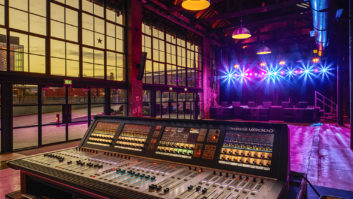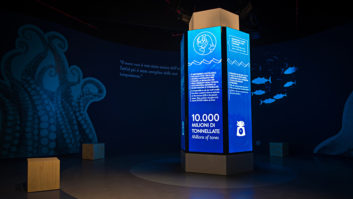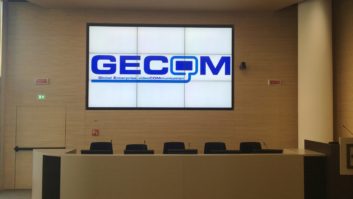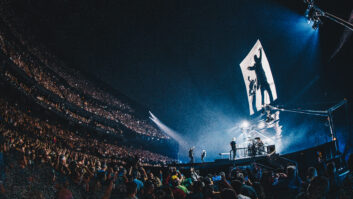It turns out that, despite webcams, webconferencing, videoconferencing – and, yes, despite telepresence – when people want to talk to each other, a popular option remains that they actually get together in a room and speak face to face. It may seem old-fashioned, but that’s not to say that some pretty exciting technology isn’t being applied to improving the experience, nor that the industry which develops and integrates that technology isn’t thriving. Nothing could be further from the truth.
Everyone is talking about the impact of digital technologies. Inevitably, wireless is making its mark – although the industry is divided as to whether it’s yet sufficiently mature. Functionality is expanding rapidly – well beyond simply providing a better aural experience – to include voting systems, translation systems, meeting management capabilities and much more.
Conni Vang Jensen, marketing manager at Danish Interpretation Systems (DIS), says: “Digital technology has changed everything. From connecting units with standard Cat-5 cables to being able to broadcast meetings directly to the internet, from audio recording on a hard disk to voting via touchscreens and login procedures with chip cards. Everything is much easier and gives users much more functionality.”
“Digital technology allows us to send the audio and video through a site’s intranet so that council officers can watch the meeting in their offices,” notes Jon Hunnisett, managing director of audio systems integrator Sound Advice, which specialises in local authority contracting. “They know what stage the meeting is at. If they have to give a presentation to the council, they now don’t have to waste all day sitting in a meeting.”
Stuart Cunningham, general manager of distributor CUK Audio, says: “Digital technology has helped to add a lot of functionality and take some of the complexity out of conference systems. One big advantage that digital systems have over older analogue systems is the amount of data that can be sent down a single cable. The DIS DCS6000 system can have eight channels of audio from floor microphones, plus 32 different languages distributed over the system, via inexpensive Cat-5 cable, simultaneously.”
He continues: “Digital systems also have greater scope for upgrades. Customers purchasing a simple push-to-talk discussion system can add voting, interpretation, agenda and delegate management, web streaming and archiving, and many other features at a later date simply by adding to their current system, not replacing it with a new one.”
Another option
Digital isn’t the only show in town, however. “Analogue systems are not outdated: a lot of the functionality is the same in both types of equipment, and there are many applications where it works just as well,” notes Gerhard Bauer of Brähler ICS, which has been manufacturing simultaneous interpretation, microphone and audience response systems since 1958. “It could be that many customers ask for it just because they’re more used to it in their home lives. It’s true, though, that digital systems typically offer better dynamics when compared with the signal-to-noise ratio of analogue systems, audio processing is easier, and installation time – at least in terms of wiring – is shorter. On the other hand, getting the software set up correctly in the digital world can be more problematic.”
He points out that Brähler’s CDSVAN system has featured DSP technology for close to 10 years, providing improvements in audio signalling: where once the transfer of 16 audio signals from one end of the conference hall to another outlet room required the use of a bulky multicore audio cable, now, a single Cat- 5 cable allows 32 channels to be transferred. For Cunningham, though, the most important development of the past year has been the launch of the DIS DC6990P colour touchscreen.
“The DC6990P allows conference units to display useful information such as agenda, delegate information, voting results and so on,” he says. “Using a touchscreen allows the user interface to be changed depending on requirements; previously it would be necessary, for example, to specify the number of voting buttons required at the time of order and this could not be changed. Now, it is simply changed using software. The touchscreen also provides a great user interface for chairmen controlling meetings – microphone control, starting voting and so on.”
Jan Wintersberg, managing director of German distributor prodyTel, is equally enthused by the potential of touchscreen technology. “Integration with PCs for PowerPoint presentations and internet access are also becoming hot topics,” he notes.
The requirement for internet access has been recognised by Bosch Security Systems with the introduction of the company’s DCN Next Generation touch panel. “Speaking and listening are standard functionalities,” says Ruud Michiels, the company’s product marketing manager for conference systems, “while language selection, chairperson priority and voting units are available as options. Beyond this, not only does the panel allow delegates to follow voting results visually, for example, but it also gives them access to internet browsing, file sharing and messaging.” He goes on to point out that, as the DCN system is softwaredriven, functionality can be customised according to customer requirements.
Behind the scenes
But if a programmable, upgradeable and easyto- use delegate interface is the most visible application of new technologies to conference audio systems, it is also true that much less visible technologies are addressing the fundamental requirement that each speaker can be heard easily.
Here, says Matt Nettlefold, product manager at beyerdynamic, the key advance has been in the use of line-array microphone technology. Line arrays have been traditionally used in loudspeaker systems to improve the ‘shape’ of the delivered sound – and applying the same technology (supplemented by the DSPs which are finding multiple applications in conference audio) allows today’s microphones to compensate for the perennial problem of a presenter who wanders away from the microphone, meaning that his voice fades in and out. “Even when the speaker turns his or her head, stands up or leans back, the sound quality and audio level remain virtually the same,” says Nettlefold. “Because the pick-up pattern of Revoluto – our new line array microphone system – is considerably more extended than that of traditional gooseneck microphones, it provides constant sound quality. The result is that the speaker can completely focus on his or her talk and listeners.”
He also notes the advent of 2.4GHz wireless conference microphone products, first introduced to the market in 2001 by the company’s MCW-Digital system.
Wireless issues
Another hot topic in the conference audio industry is wireless – which has its share of proponents and opponents. In the former camp are Hunnisett and Nettlefold. “Today, 80% of the systems we’re selling are wireless,” says Hunnisett, “and everyone who uses them is thrilled with the flexibility they provide. “The UK council market in particular has shown a marked increase in demand for wireless systems to replace older wired systems because they’re more portable, and because the lack of wiring reduces the impact of installation.”
On balance, though, the industry remains sceptical. Vang Jensen, for example, says: “We see that some of our competitors are launching wireless systems. However, we do not yet believe in wireless. There are security issues as the radio waves may be caught by others – and there are so many other electronic devices using the same radio bandwidth, giving the potential for disruption. Another issue is recharging: you may have, say, 20 hours of use before you have to recharge the units, and that’s a big job during a conference. Some units even have to be put in a charger, which takes up a lot of space.”
Bauer agrees. “Wireless can never be as reliable as wired,” he says. “Air is a weak medium for data transportation, and, unlike wi-fi systems, data transmission within conferences cannot accept data losses like in wi-fi connections. Yes, wireless technology is improving, and it’s unquestionably popular for temporary installations and for buildings where laying cable is not, for whatever reason, practicable, but there is still a demand for wired systems because of their higher bandwidth and perceived better security.”
“Channel limitations can certainly be a problem with wireless,” echoes John Willett of Sennheiser UK. “Encryption to improve security has been a neglected area – and there is also the issue of possible interference from wi-fi and Bluetooth to be aware of.”
Peter James is sales manager for commercial audio at Shure Distribution UK, and he is clear as to what the issues are with wireless. “The issue for us is not merely one of maturity,” he says. “Radio frequency spectrum is already in short supply – at least here in the UK – and licence-free portions of bandwidth, such as the ISM bands at 1.8GHz and 2.4GHz, are already congested with a multitude of devices, only some of them audio related. Spectrum-efficient devices using digital technology are already reaching the marketplace but their wireless performance is at the expense of audio quality.”
“The problem is the latency (delay) as it takes time to convert an analogue audio signal to digital, transmit it, receive it, and convert it to back to analogue,” he continues. “That may be fine for digital TV and digital radio, but it’s not acceptable when you are in the room with the person speaking. To minimise the latency, we can compress the signal – but that means a decision to discard some of our audio signal and a loss of quality.
“The UK government is trying to resolve the terms and amount of RF spectrum available for radio microphones after the digital TV switchover, but until then, product development and the release of new technologies will be somewhat delayed. Whatever the outcome, we remain committed to designing and manufacturing products that provide for the most accurate and uncoloured audio reproduction.”
Nettlefold is confident, however, that beyerdynamic is going in the right direction. “For our wireless conference systems,” he says, “we use 2.4GHz Direct Sequence Spread Spectrum (DSSS) as our wireless transfer protocol, due to its advanced security and stability in adverse environments.”
If there is any kind of dark cloud looming on the conference audio horizon, it may be in the field of standards and open architectures. Vang Jensen is candid. “The majority of conference systems are based on proprietary architectures,” she says. “That means that a Bosch conference microphone and a beyerdynamic microphone cannot talk together. Our own DIS is also a proprietary architecture.” “For beyerdynamic wired systems, we have a product-specific architecture for interlinking microphone units, due to the nature of the digital communication and networking of the product,” points out Nettlefold.
“Basically all conference systems are based on their proprietary architecture protocols,” says Bauer. “Combining conference systems from different manufacturers is possible, but is dependent on the skill of the integrator. All manufacturers are building their own ‘cars’ – but at least they’re all are driving on the same ‘roads’.” Bauer’s alludes to the fact that, while the majority of conference audio architectures are vendor-specific, they at least tend to use industry standards with which to build or connect them. Vang Jensen adds: “We use standards where possible. For example, our SW 6000 Conference Management Software uses a standard Microsoft SQL database, and can import data from similar databases. All our units are connected with standard Cat-5 cable, while the software running on the newly launched DC 6990P with its touchscreen is running on Linux.” Equally, open technologies such as CobraNet, RS-232, XML and so on are widely used.
“Nearly all conference systems are based on proprietary technology,” says Cunningham. “However, I wouldn’t say this is a problem – so long as customers choose a manufacturer that can meet their requirements. And, even if the technology is proprietary, it is simple enough to integrate conferencing systems with third-party control products – such as those from AMX and Crestron – and with other audio products to produce complete solutions.”
“If the customer wants something that the manufacturer doesn’t support, we just write our own code,” says Hunnisett. For as long as conference audio systems remain ‘islands’ within an organisation’s overall IT and communications infrastructure, this may not be an issue – although there are some in the industry who can’t see the functional justification for a higher degree of integration than exists today. “It makes no sense at all, because you do an audio conference out of a room, not out of a building,” says Wintersberg. “Building applications are more about sound reinforcement. Connecting both is technically possible, but makes the installation more complicated as well as increasing its cost unnecessarily.”
Willett, however, disagrees. “We’re seeing something of a trend towards greater integration,” he says. “This is a good thing as the conference system can be linked with the AV system and the internet so that a delegate can use a touchscreen and has the ability to run PowerPoint, for example, directly from his seat and to search the net and display immediately to the conference.”
“Conference audio systems are usually only integrated with the audio systems in the same room or suite of rooms,” notes Cunningham. “Integration with an induction loop system, public address system and archiving/recording are common. Even allowing multiple audio conference systems in different rooms is a fairly regular requirement. “I think the reason conferencing systems are rarely integrated with the overall audio system of a building – like paging, background music and so on – is that there are not many instances where this is required. Technically there is nothing to stop it happening.” There are others, however, who can see the justification. Nettlefold is one. “In most instances, the conference system is being integrated into the overall audio system within most buildings,” he says, “for use in teleconferencing, and integration within PA systems for audio support, for example.”
Bauer is another. “Integration is becoming more prevalent,” he says, “especially in bigger, multi-purpose buildings, where flexibility is very important for customers and their end users. It seems probable that new legislation about emergency systems may see integration becoming even more important in the future.”
Both, however, note that the ‘island’ of conference audio functionality is likely to remain a mainstream requirement.
That’s equally true for other functionality that might have been considered somewhat exotic until not long ago. Cameras that automatically track who is speaking and relay the image to delegate screens; voting systems; ‘digital stenography’, in which meetings are automatically recorded and saved to a PC; translation systems; use of video and integration with PCs, the IT infrastructure, videoconferencing and web-based conferencing are all becoming ‘requirements’, rather than ‘nice-to-haves’, as users become increasingly sophisticated.
“Yes, the demand for more features is increasing,” notes Wintersberg, “but the other trend is also to make complex systems almost ‘plug and play’.”
“It’s no longer enough for conference audio systems just to deliver microphones, an amplifier and some speakers so that everyone can hear what is being said,” says Hunnisett. “Today, 50% of our customers have voting, 75% have video – and nearly all are asking to be ‘webcast ready’. Beyond that, three of the councils with which we’ve been working have recently enquired about interpretation as they have a high level of citizens for whom English is not their first language.”
“Certainly, integration of additional functionalities is key at the moment and with good reason,” says James, “but there is still a divide between a product performing a number of integrated functions and an integrated system of products performing different functions. Demand for voting, streaming and translation are certainly on the increase but some of this demand is driven by product comparison. Comparing the number of integrated features to price is the simplest measure of value – but this frequently bypasses any quality considerations. We should never lose sight of the fact that audio is the most essential element of any conference, and that while the thirst for new technology can make conferencing more viable and productive, it’s pretty much non-viable and non-productive without good audio.”
“Uncoloured, accurate audio reproduction is essential to productive conferencing and meetings,” he concludes. “More importantly: voting, translation and streaming are far less effective if delegates cannot hear properly, so these new technologies and their increasing integration are very positive for anyone involved in the provision of quality professional audio equipment.”
The good news is that the manufacturers serving the conference audio industry are fulfilling these needs with ranges of innovative products – while integrators are delighted to be serving a challenging market that is growing and that continues to require significant added value in terms of expertise and skills.







